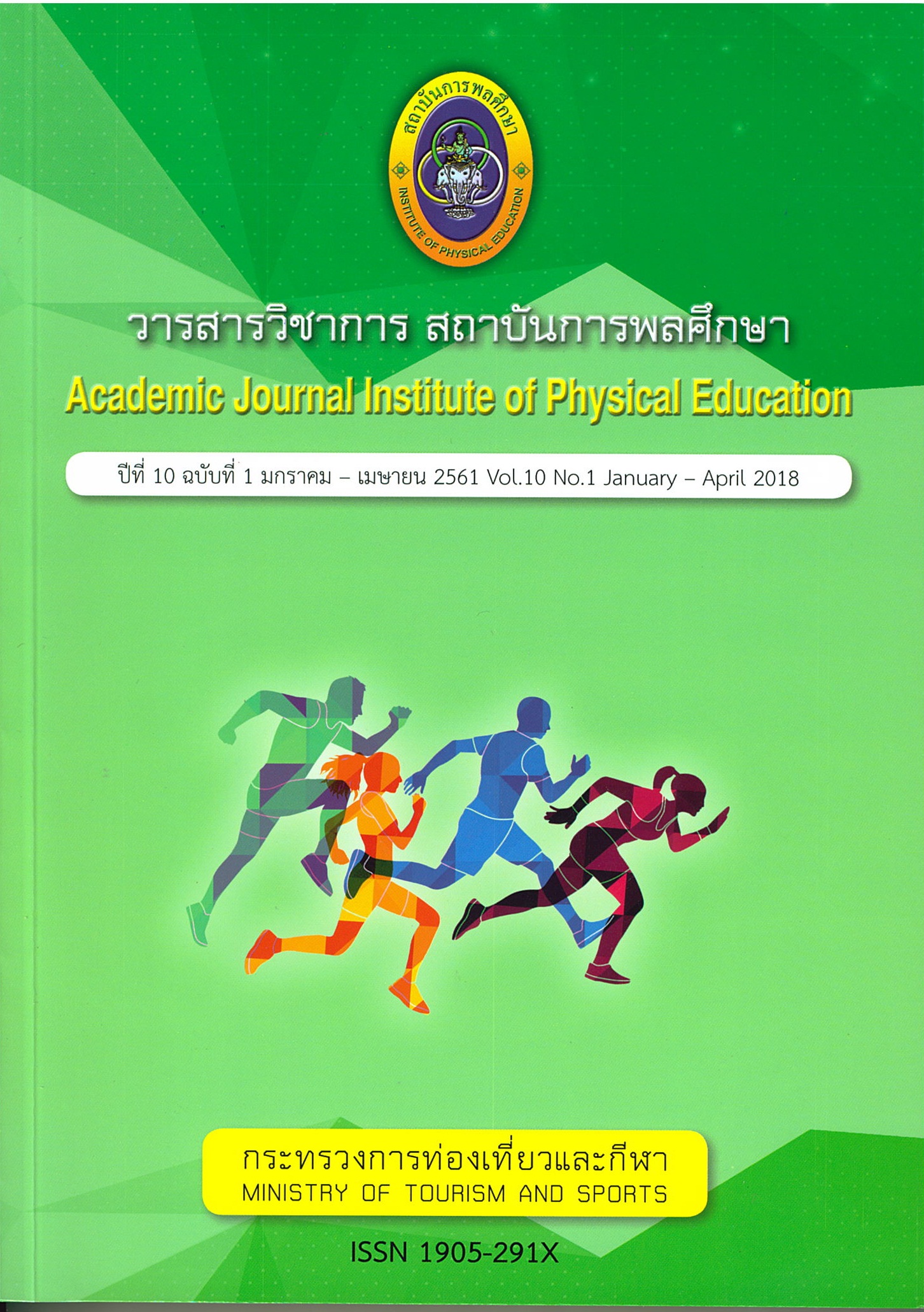Desired Characteristicsof Physical Education TeachersInThe 21st Century According To Teachers And EducationPersonnalIn TheChantaburi Primary School Of Education Service Area 2
Main Article Content
Abstract
The purposes of this research were to study the desired characteristics of physical education teachers in the 21st century according to teachers and education personnel in the Chantaburi primary school of education service area 2, and to study the relationship of the elements for the desired characteristics of physical education teachers in the 21st century according to teachers and education personnel in the Chantaburi primary school of education service area 2. The sample group consisted of school directors, vice directors for academic affairs/academic chief, educational institute committees, and parents, totally 377 persons. The research instrument was 5 points Likert rating scale about the desired characteristics of physical education teachers in the 21st century. The scale consist of 7 aspects according to Griffiths’ concept (Griffiths, 1956), including; initiator, improver, recogniver, helper, effective speaker, coordinator, social man. by finding the Alpha-Coefficient of Cronbach (Cronbach. 1994: 202-204).The validity of questions was 0.98.
The research results revealed that the desired characteristics of physical education teachers in the 21st century according to teachers and education personnel in the Chantaburi primary school of education service area 2 as overall aspect and each aspect were at a high level. When considering each aspect, it was found that the aspect which had the highest mean was about good sociability, secondly was about giving help, giving respect, motivation, creativity, co-ordination, and improvement, respectively. According to the correlation coefficient between the variables, it was found that the highest relationship was about creativity and improvement, secondly was about the relationship between co-ordination and sociability, the relationship between giving help and giving respect, and the relationship between creativity and motivation, respectively. The statistical significance was at 0.01levels.
Article Details
The published article is a copyright of the Academic Journal of Thailand National Sports University. The passage appeared in each article in this academic journal is a perspective of each author which is not related to the journal. Each author is required to be responsible for all components of his/her own article. If there are any mistakes, each author must be responsible for those mistakes on his/her own.
References
กมล สุดประเสริฐ. (2553). คุณลักษณะของครูประถมศึกษาที่ดี. กรุงเทพฯ: ธนกิจการพิมพ์.
ชนัย สงวนทรัพย์. (2529). การศึกษาพฤติกรรมการสอนของครูดีเด่น สังกัดสำนักงานการประถมศึกษาจังหวัดชลบุรี. ปริญญานิพนธ์การศึกษามหาบัณฑิต สาขาวิชาการบริหารการศึกษา มหาวิทยาลัยศรีนครินทรวิโรฒ บางแสน.
ชาญชัย อาจินสมาจาร. (2538). ครูและอาชีพของครู. ประชากร, 9(45), 37-39.
ธนู แสวงศักดิ์. (2525). ครูดี. วิทยาจารย์, 2(11), 65-100.
บรรจง จันทรสา. (2522). ปรัชญาการศึกษา. กรุงเทพฯ: ไทยวัฒนาพานิช.
พิมพันธ์ เตชะถุปต์ และพเยาว์ ยินดีสุข. (2551). ทักษะ 5 C เพื่อพัฒนาหน่วยการเรียนรู้และการจัดการสอนแบบบูรณาการ.กรุงเทพฯ: โรงพิมพ์แห่งจุฬาลงกรณ์มหาวิทยาลัย.
วรศักดิ์ เพียรชอบ. (2548). ปรัชญา หลักการ วิธีสอน และการวัดเพื่อประเมินผลทางพลศึกษา. กรุงเทพฯ: สำนักพิมพ์แห่งจุฬาลงกรณ์มหาวิทยาลัย.
วิภาวี เวทวงศ์. (2545). การวิเคราะห์องค์ประกอบเชิงยืนยันคุณลักษณะของครูดีเด่นสายงาน การสอนระดับการศึกษาขั้นพื้นฐาน.ปริญญาวิทยาศาสตรมหาบัณฑิต สาขาวิชาเทคโนโลยีวิจัยการศึกษา. คณะวิทยาศาสตร์ มหาวิทยาลัยบูรพา.
สมชาย โพธิ์แก้ว. (2547). คุณลักษณะความรู้ความสามารถที่พึงประสงค์ของครูในทศวรรษหน้า (พ.ศ.2547-2557).ปริญญาศึกษาศาสตรมหาบัณฑิต สาขาวิชาเทคโนโลยีวิจัยการศึกษา. มหาวิทยาลัยมหาสารคาม.
สำนักงานคณะกรรมการการประถมศึกษาแห่งชาติ. (2534). ประสิทธิภาพการบริหารโรงเรียนประถมศึกษา. กรุงเทพฯ: สำนักงานคณะกรรมการการประถมศึกษาแห่งชาติ.
สำนักงานปฏิรูปการศึกษา. (2542). พระราชบัญญัติการศึกษาแห่งชาติ พุทธศักราช 2542. กรุงเทพฯ: พริกหวานกราฟฟิค.
สำนักงานส่งเสริมสังคมแห่งการเรียนรู้และคุณภาพเยาวชน. ยุทธการเปลี่ยน“ครูเฉย”สู่ครูยุคศตวรรษที่21. สืบค้นเมื่อ 18 กุมภาพันธ์ 2558 จาก http://seminar.glf.or.th/seminar/Topic/29
อาภร หงส์สมบัติ สุกัญญา บุญน้อม และไข่มุก บุญส่ง. (2555). คุณลักษณะที่พึงประสงค์ของบัณฑิตคณะศิลปศาสตร์ตามความต้องการของผู้ประกอบการในเขตพื้นที่รับผิดชอบของสถาบันการพลศึกษา วิทยาเขตสุพรรณบุรี. วารสารวิชาการ สถาบันการพลศึกษา,4(3), 27-44.
เอกวิทย์ ณ ถลาง. (2532). คุรุวาทะ. กรุงเทพฯ: โรงพิมพ์พิฆเนศ.
Cronbach, L.J. (1994). Essentials of phychological testing (3rded.). New York: Harper & Collins Publishers.
Griffiths, D.E. (1956). Human relations in school administration. New York: Appleton Century-Crofts.
Krejcie, R.V., & Morgan, D.W. (1970). Determining sample sizes for research activities. Educational and psychological measurement, 30(3), 607-610.


